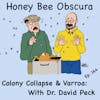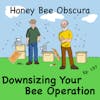How to Deal With Broken Frames (142)

This is honey harvest time of the year, for the majority of the beekeepers in the Northern Hemisphere. Undoubtedly, you will end your uncapping and extracting time with frames with broken end bars, bottoms or even the foundation punched through or...
 This is honey harvest time of the year, for the majority of the beekeepers in the Northern Hemisphere. Undoubtedly, you will end your uncapping and extracting time with frames with broken end bars, bottoms or even the foundation punched through or out. Do you save it? Replace it? Or... something different.
This is honey harvest time of the year, for the majority of the beekeepers in the Northern Hemisphere. Undoubtedly, you will end your uncapping and extracting time with frames with broken end bars, bottoms or even the foundation punched through or out. Do you save it? Replace it? Or... something different.
In today's episode, Kim and Jim discuss what a beekeeper can do to keep these old and/or broken frames going. Bees can fix many mistakes the beekeeper makes with the uncapping knife or machine. But should they? Can you repair frames with plastic foundation inserts or even rewiring a frame and using pure wax foundation. But what is your time worth?
Listen in as Kim and Jim discuss the pros and cons about trying to save frames that have served well but are now done.
______________________
Thanks to Betterbee for sponsoring today's episode. Betterbee’s mission is to support every beekeeper with excellent customer  service, continued education and quality equipment. From their colorful and informative catalog to their support of beekeeper educational activities, including this podcast series, Betterbee truly is Beekeepers Serving Beekeepers. See for yourself at www.betterbee.com
service, continued education and quality equipment. From their colorful and informative catalog to their support of beekeeper educational activities, including this podcast series, Betterbee truly is Beekeepers Serving Beekeepers. See for yourself at www.betterbee.com
______________________
Honey Bee Obscura is brought to you by Growing Planet Media, LLC, the home of Beekeeping Today Podcast.
Music: Heart & Soul by Gyom, All We Know by Midway Music, original guitar music by Jeffrey Ott
Copyright © 2023 by Growing Planet Media, LLC

Episode 142 – How to Deal With Broken Frames
[music]
Kim Flottum: A guy I know came over the other day. He had a bunch of stuff in a black plastic bag, and I know that's never a good thing. He brought it in. I was working in the garage, picking up junk or whatever it was I was doing. He brought the bag in, he set it on the floor, he reached in, and he pulled out a frame. He said, "I got a whole bunch of these." I looked at the frame. What had happened was whoever had uncapped that frame earlier was a little bit too aggressive and had punched the foundation out. There was this hole in the middle of the frame. He said, "How do I fix this?"
Jim Tew: I've got this mental picture, Kim, of a frame like somebody getting a bad haircut, where the hot knife went too far down and punched right through the wax cappings, the wax foundation, and then left a mutilated mess there. I don't know what you said to him, but, number one, he doesn't fix it, the bees have got to do it if anything is going to fix it. How many of these did he have, and where did you go with this, and do you want to talk about this today?
Kim: Yes, I do, because it's something you run into with people who haven't been doing bees all their life. Hi, I'm Kim Flottum.
Jim: I'm Jim Tew.
Kim: We're here today on Honey Bee Obscura to talk about, I guess you'd call it, broken frames, broken foundation, or both.
Introduction: You are listening to Honey Bee Obscura, brought to you by Growing Planet Media, the folks behind Beekeeping Today podcast. Each week on Honey Bee Obscura, hosts Kim Flottum and Jim Tew explore the complexities, the beauty, the fun, and the challenges of managing honey bees in today's world. Get ready for an engaging discussion to delight and inform all beekeepers. If you're a long-timer or just starting out, sit back and enjoy the next several minutes as Kim and Jim explore all things honey bees.
Kim: I took a look at the frame. It wasn't brand new, but it wasn't too old. I said, "How many of these you got?" He said, "You don't want to know."
Jim: That's an interesting story because it seems to me that in our beekeeping equipment, we're in this transition phase. You can still get old-fashioned, established, traditional beeswax foundation, or you can buy these new heavy-duty plastic inserts. Kim, more and more, I've been going to the inserts. You just pop those things out, pop the inserts in, and their wax moths have a more difficult time eating through it. For this guy to bring in that traditionally wired-- was it wired or was it just some plastic center foundation?
Kim: It was all of the above.
Jim: Let's just go with this. You have to describe it. I don't know what you told him. Let's see how this works out. It can be repaired if it should be repaired. Kim Flottum always says, "What's your time worth?" I'm going to quote him on this. I think you probably agree with him and ask, how much is this? How old was the frame? How dark was the comb? Everything's in the details here, right, Kim?
Kim: Yes, exactly. That's why I wanted him to stay around. The first thing I said to him, I said, "Well, time is money. How much time do you have compared to how much money it will cost you to repair all of this or to replace all this?" He said, "I don't have a clue." I said, "Okay, your first job is going to be, go home today, take a look at a couple of catalogs or go online and see what's it going to cost you to replace this whole unit, frame, foundation, everything, and have it shipped to your house ready to put into your beehive."
I said, "Your time will be almost zero. Your cost will be the cost of the frames and shipping." Well, he did that and he came back and he said, "I don't have a clue. I looked at that catalog, there's got to be 87 million kinds of things you can do with a frame and foundation." I said, "Welcome to the world of bees and beekeeping."
Jim: You're overloading me here because there's about just 10 discussion points that you just went right through. First of all, time is money, but where are you on your beekeeping journey? Many times I've done things that were impractical just because I wanted to. Kim, as time passes, you get that out of your system. If this person wanted to restore those frames just to see how the bees would do it, how he would do it, that's one thing.
More often than not, starting over, if those combs could be destroyed that easily, you probably want to do a different technique the next time. I really believe that's probably going to include heavy-duty foundation inserts that are not perfect but they are heavier-duty and don't require the labor that the old frames required.
Kim: Yes, almost no labor at all. Time is money. You're saving a lot of time with those. He went home that day and took a look, and like I said, he came back and he said, "I don't know what you're talking about. There's 87 million things that I can put in this frame to replace that wax." I said, "Okay, let's start at the beginning. What was this? Where did you get it and why?" He said, "Well, I went to my local bee supply dealer and I bought an assembled hive, bottom board, two deeps, inner cover." I said, "Why did you buy this one compared to the one sitting next to it?" He said, "There was only one kind there, so I had to take what I could get."
All right, that makes sense. Then I said, "All right, how much did this cost you and what's your involvement financially in this frame? You can figure that out. You call up that dealer and you say, 'I want to buy 10 frames like this one. What's it going to cost me if I come and pick them up?'" "Okay, I can do that." He came back and it was $250 or something, whatever it was, and he said, "That's a lot of money when I got this many. Am I going to have to replace all my frames because these weren't very good or my uncapper friend wasn't very good?"
Jim: I'm wondering while you were talking why they got cut so much off? You just have to be there. If the frames weren't filled out nicely, the combs weren't filled out nicely, they weren't high, then you gouge, you scratch, you do whatever. When there's all is said and done, the bees can repair it. Kim, you and I both know what's going to happen when you put those combs back in the colony. You're going to get a lot of drone combs. You're going to get some misaligned and screwed-up-looking combs there.
What would you actually tell this person to do? To rewire it, re-foundation it? The path of least resistance if you're talking money, can you just put it back in the bees and see what they do with it? Then the frames that did not recover nicely, it's going to be next season. The frames that did not recover nicely, then pull those out and redo those. Instead of redoing all the frames, just redo the ones that the bees didn't recover from.
Kim: Let me tell you what he had in that plastic bag specifically. He had two kinds of frames. He had a wooden frame he had assembled, and in that, he'd wired the frames, and then he was going to put a wired foundation in it. That's what he did.
Jim: This is going back several generations ago, but all equipment is still available. The embedders, the electric embedders, the spur embedders, the eyelets, it's all right there. This is confusing for new beekeepers. It's confusing to me, and I'm an old beekeeper.
Kim: I want to say the problem was, it wasn't really a problem. He started by looking at a couple of fairly old how-to books. These how-to books were telling him that's what he needed to do. He said, "I looked at that, I thought, 'Maybe there's something better.'" Other frames that were in that bag were wooden frames that he had bought a plastic sheet of foundation to snap in the middle of. When that uncapper went down, it only went down that far. It went down to the plastic frame, gouged out all of the comb.
He said, "Can this be fixed? Can the bees fix this?" Like you said, what the bees will do is what the bees will do. Do you want to take the chance of not doing anything, essentially putting that frame back in the box, having it take up a bunch of space for the bees to screw it up, and two or three weeks, four weeks from now, you're going to have to pull it out and get rid of it?
Jim: Everything you said is true. We've talked about all these various options and techniques. Let's take a break and hear from our sponsor who has some of the products we're talking about.
Betterbee: It's summertime, and the Varroa population in your hives is booming. Target Varroa now with Apalife Var to protect your hives from mite-borne diseases down the road. With over 30 years of international use, Apalife Var is a natural, thymol-based treatment with an effectiveness that exceeds 94%. Learn more and get yours from Better Bee today by visiting betterbee.com/alv.
Jim: I don't know what to say, Kim. If you say put it back in and wait till next season and see what the bees do, you are taking a chance. I completely agree. It may be a messy comb, a messy recovery job. If that person had foundation inserts for most of the front combs, the old wired foundation or how much of it was the foundation inserts, they can be recovered, I think.
Kim: Those plastic inserts?
Jim: Yes, the plastic heavy, you can almost bang them on the table. They're so heavy, those gadgets.
Kim: Yes, they're available. I talked to him about that. Then I talked to him about, "Okay, when this comb needs to be replaced, you've had it three years in this hive, it's almost black, and you need to replace the wax. How do you get the wax off a piece of plastic foundation and get all of the wax off that piece of plastic foundation because all of that wax has some level of agricultural pesticide problems with it?"
Jim: For me, I can't get it all off. I wouldn't spend that much time. The only way I could get it off completely is to pressure-wash it and just blow it to smithereens. What a job that is, Kim, because you're soaking wet and you've blown wax stuff all over the side of the shop where you're working outside, and what a mess. I'm not going to get it all off. I just can't do it. If you want to get it all off, you need to completely start all over again. Am I wrong there?
Kim: Not one bit. That's exactly right. Pressure washing an old frame, you might get it clean after 3 minutes, 10 minutes, 20 minutes, turning it over, doing it again, turning it over, doing it again. You might end up with a piece of foundation that's relatively clean. I'm going to say relatively clean in that it's clean enough for me to believe that there's not hardly any toxic wax left. What's the cost of my time doing that as opposed to buying a new one, taking that one, putting it in the wax melter, melt the wax off it? The plastic insert will curl up like crumpled paper.
Jim: Yes. When you heat it goes wrong.
Kim: That's all you're losing is that piece of foundation that's got toxic wax on it.
Jim: Let me say what I think you've said. On the combs that the man brought to you, and I hope he never gets my name and address, with this mutilated uncapping process, the combs that were on plastic inserts, you're saying just knock those inserts out, replace the insert, you get new wax and you start all over again, it just took you 30 seconds to do it. I was wondering if that insert could be saved, but if you don't want any wax on it because of agricultural contamination and in-hive contamination, if you don't want any wax at all, then you're really going to be working to get all the wax off, pressure-washing, and I saved all the headache of that.
There's a pathway on that. The path of least resistance and the safest path is just to replace the foundation insert, recycle that plastic, I guess, and start over. That doesn't explain what to do with the wired frames. Kim, those are almost not worth even saving the wooden frame. I cannot believe that I'm saying that because I've got a plaque. I can look over here across the room right now. There it is hanging on the wall that says, "Anything can be fixed." In reality, the older I've gotten, it needs to have a caveat added underneath that sign that hangs on the wall that said it shouldn't always happen.
Those frames that didn't have the foundation inserts in, I don't know if I would try to save those or not. The wedges are tacked in. There's propolis and it's glued up. There's wiring everywhere. If you had the eyelets and the end bars, there's all that to deal with. If you want to think these frames are going to last forever, they're really not. Not even the wooden parts of the frames are going to last forever. If you've got plastic single-unit frames and they're mutilated, I'm thinking just start over again.
Kim: That's where this went fairly quickly. What I started to do, going through that catalog, a different one than he'd looked at but the stuff was about the same, and pointing out what his options were. I'm looking at this again from time is money perspective, as opposed to I enjoy working wood and getting the smell of wax and doing all of that. I just said, "I got to have 10 frames in this box before lunch because that's when I'm leaving. That's what you got to do."
We talked about what he had. "Do you want to replace what you had with more of the same?" He looked at me and he said, "No, maybe not." Then I said, "Well, what about plastic foundation embossed with wax that you put on so you know that your wax, your frames are clean so when your bees get in there, they're not in a toxic environment?" He liked that thought. Then I looked at the standard, the stuff that's been used since Langstroth, just a beeswax sheet embossed.
Jim: Right, embossed beeswax template.
Kim: Yes. I looked at that and I showed him. I said, "Here's what you can do with that. In three years, it's all going to go away again anyway because the wax will be dirty, stuff in it, whatever you want." He said, "Well, what's the best choice for me here?" "You can use wax foundation only, wax foundation that's wired, wax foundation, or plastic foundation only, plastic foundation that's waxed or double waxed. All of those things are going to work.
"You have to get rid of what's in the middle of those broken frames, in my opinion, probably all of your frames, and start over again with one of those choices. If you have extraction issues with the people that help you, rather than yell at them, just assume they're going to keep punching out the middle and get them something they can't punch. You will be happy, they'll be happy, and you won't have spent four months extracting two supers of honey.
Jim: I don't know that I can argue that. From the sake of starting over, getting the equipment ready to go, storing it, making it heavy-duty, if you have people helping, it seems like the best plan that you've come up with.
Kim: Apparently it was. He liked what he saw when he saw the things that I mentioned, but then I showed him something he hadn't seen anywhere before. It was that one-piece plastic frame and foundation, all one piece of plastic. He said, "This looks like I take it out of the box and put it in the hive." I said, "Yes, pretty much. You can get these frames with somebody else's wax already on them or get them unwaxed and wax them yourself. Then what you're going for. Basically, it's taking them out of the box and putting them in another box and you're done. You not only will be done before lunch, you'll be done before coffee break."
Jim: I'm not totally unlike the person you're describing. I've got all kinds of equipment, all kinds of foundation sheets, frames, and my lifelong collection. I've got a lot of those single-component plastic frames. They are so convenient, Kim. Open the box, drop them in, good to go. The only complaint I've got, and it's a big one, is that they rack. They twist from side to side. When I'm taking the frames out to try to see if the honey is capped or whatever and that frame will slightly twist, then it cracks the cappings on there and then the honey leaks out. The bees fix it straight away.
I like the wooden frames just because they're heavier, but you got to assemble them or you got to pay somebody else to assemble them. I usually open the box and put those single-piece plastic frames and the whole time thinking, "I wish I had more time to do this more strongly than what I'm doing." I don't disagree with the concern and the confusion that beekeepers have to go through when they look at the options of foundation, frame types, three-year replacement anyway. Is this comb worth it or not? You're never done, are you, Kim? This process is never done. If you've got a great box of frames, it won't be a great box of frames just a year or two from now.
Kim: Yes. The other part of that is, you mentioned they rack or they twist. Not only do they rack and twist, often they won't fit your box. Before you buy 10,000 of them, buy 10 of them and see. If you're going to buy 10,000, I'm not going to bet you've got boxes from every supplier under the sun. If you just got two colonies last year, you can try it and see how they fit those colonies. They may work just fine, but it's the depth of the rabbits that's on those boxes that you can't adjust, that will determine does that frame go down far enough, not far enough, or too far.
Jim: You're just hitting all the weak spots. You've just gone right from the complexities of foundation and frames to rabbit depths. Is it the old seven-eighth-inch depth rabbet that's got to go have a raised frame rest or is it the five-eighth-inch flat rabbet that just uses a metal tent? I'm sorry, listeners, you've got to scrounge the breed supply catalog to be certain that you're getting what you want on this. You're right, Kim, that's another tedious area.
Kim: I don't know if I solved this problem for him. He seemed to go home happy. He left me all of the broken frames because I think he forgot them and/or he didn't want them back, I'm not sure which. Now I've got him in the solar wax melter and I'm getting his wax. What am I going to do with wax I have no idea what it's been exposed to? It might be a waste of time all the way around.
There's one more facet of this. You and I have talked about before. How do the bees like this stuff? Is there some of these that the bees really like, some that they don't like at all, or some in between? How do you tell? How do you buy 10 frames for a box and know that the bees are going to go in that box will just love these frames?
Jim: I was thinking about being sarcastic and asking you when have you and I ever been concerned about what the bees like? It's what I like and what I want to use and what's convenient for me and how I cannot coerce the bees into using it. More often than not, the bees like the closer proximity to pure beeswax, the more the bees they like it. The closer and the further we go toward plastic, the more the bees resist it as much as possible. We're out of time. I hope we covered enough to get some aspect of it done.
Kim: If you've been listening to this, sit back and listen to it again if you get the chance and look at the options you have if you're trying to make this decision. If you're first year, second year, and you got some of the frames with broke foundation, what are you going to replace it with? First suggestion, talk to everybody in your bee club. Oh, you don't belong to the bee club. Join the bee club and talk to everybody, what do they use, and then say, "Why?"
More times than not, you'll have a pretty good reason for somebody who's been keeping bees for more than 10 years. People that have been a lot shorter than that go, "Because that's what came with the hive I bought. Know that there's other stuff out there. stuff your bees might like better, stuff that's cheaper, saves you time, saves you money, all of those things, but it's going to take a while to figure out what works in your operation.
Jim: I can't word that any better.
Kim: Until next time.
Jim: Until next time. I enjoyed talking to you.
[00:22:04] [END OF AUDIO]
New to Honey Bee Obscura Podcast?
Here are some great episodes to start with. Or, check out episodes by topic.













